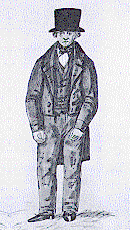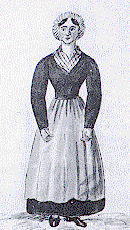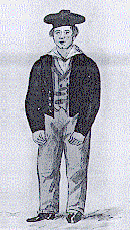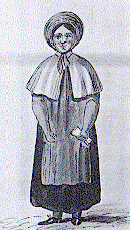Health and poor relief
Health and poor relief
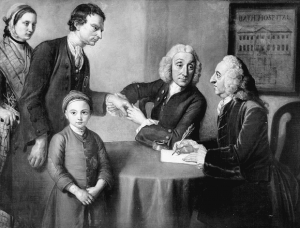
- Bath Hospital
- [click on the picture to enlarge it]
In the first half of the eighteenth century, hospitals as establishments specialized in medical care and surgery were clearly differentiated from hospices and asylums which had existed for a long time.
The number of hospitals rapidly increased in London as well as in the Provinces. The capital only had two big hospitals in 1700: St. Bartholomew and St. Thomas. In 1750, they were five more: Guy’s Hospital, the Westminster Infirmary, St. George’s Hospital, the Middlesex Hospital and the London Hospital. At this same date, nine other hospitals had been opened in certain provincial towns in the south of the country, such as Winchester, Oxford, Gloucester, Bath, Exeter, Bristol and Worcester. After 1750, it was the northern towns, such as Newcastle and Edinburgh, and above all the industrial towns of the Midlands, like Birmingham, Manchester, and Sheffield which equipped themselves with such establishments, most often located on the outskirts in order to get a better circulation of air.
The originality of the new British hospitals resided first in the way they were financed; they were all philanthropist institutions, obtaining their income both from donations and annual subscriptions. It was mainly the urban middle classes who organized the construction and financed the running of these hospitals by donations, notably from traders, doctors and the clergymen.
Admission procedures for the hospitals show that they were intended solely for the care of members of the working classes. Yet, they still needed a recommendation signed by a subscriber as well. As for the well-off, they were treated at home.
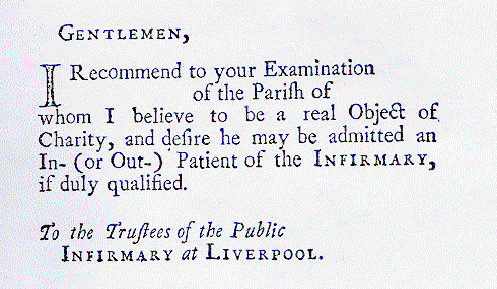
- Letter of recommandation for a patient at Liverpool Hospital in the 18th century.
- GENTLEMEN,
I Recommend to your Examination of the Parith of whom I believe to be a real Object of Charity, and defire he may be admitted an In-(or Out-) Patient of the INFIRMARY, if duly qualified.
To the Thuftees of the Public
INFIRMARY at LIVERPOOL.
[click on the picture to enlarge it]
Hospitals did not treat all infections. The most frequent illnesses treated at the hospital were listed by a French contemporary : “Paralysis, dropsy, consumptions, fevers, leprosy, rheumatisms, cholics, kidney stone complaints, as well as numerous ulcers, fractures and sprains” *. On the other hand, certain patients were generally excluded: pregnant women and young children, the dying, the incurable, demented patients and epileptics. People with venereal diseases, and in general all those suffering from infectious diseases were undesirable, because of the fear of contagion. At the end of the century, hospitals specialized in the treatment diseases designated under the name of ’fevers’ were opened for these people.
Lunatics were sent to ’Bedlam’ Hospital in London (St Mary of Bethlehem), and to its dependent St Luke’s Hospital.
The organisation of treatment and hospital life was rigorous.
Food and prescriptions were adapted - taking into account what was known at the time - to the type of illness. Hygiene on the premises was ensured as much as possible by regular cleaning and sometimes the adoption of iron beds. Hierarchy was strict for the staff and discipline reigned in the patients’ rooms. What M. Foucault calls “l’écriture hospitalière” (hospital records) developed. That is to say that registers were kept indicating essential information for each patient, the treatment followed and the result of the care. In this way, statistics on cures and mortality rates became available.
The architecture of the new British hospitals in the 18th century was remarkably innovative. Undeniably, the external decoration remained sober for economy’s sake, but all the efforts of the builders focused on the distribution of space according to the different hospital activities. The traditional plan in the form of a quadrilateral, that could still be found at St. Thomas Hospital was soon abandoned for longer buildings with two wings, sometimes flanked by perpendicular wings and consisting of lengthwise corridors, which allowed better airing. The renewal of air in hospitals was considered more and more as an absolute health necessity, and ingenious systems of ventilation were perfected. From 1750, the British alone possessed the most modern hospitals in Europe, which were the admiration of foreign visitors.
* “Paralysies, hydropisies, consomptions, fièvres, lèpres, rhumatismes, coliques, maladie de la pierre, ainsi que quantité d’ulcères, fractures, foulures”.
St Thomas and St George’s Hospital
These paintings are part of a series of views of hospitals, both civil and military, which hang in the Court Room of the Foundling Hospital in London.
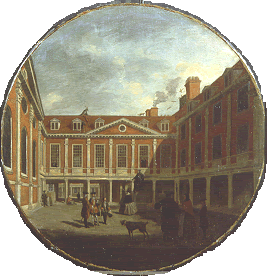
- View of St Thomas’s Hospital
- View of St Thomas’s Hospital, rehauled in the late 17th century, with its traditional quadrangular plan. (Samuel Wale, oil on canvas, ca. 1745, Foundling Museum, London / Bridgeman Art Library).
[click on the picture to enlarge it]
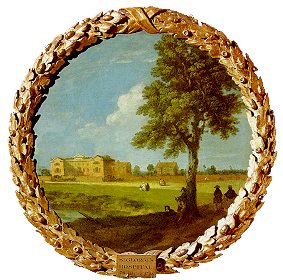
- View of St George’s Hospital
- View of St George’s Hospital, opened in 1733 on the Western outskirts of London (Richard Wilson, oil on canvas, ca. 1745, Foundling Museum, London/ Bridgeman Art Library).
[click on the picture to enlarge it]
Workhouses
Although one tends to associate the horrors of the workhouse with the age of Dickens, some of these institutions had first been set up in the early 17th century, in the wake of the Elizabethan Poor Laws. They were one of the means of delivering poor relief at parish level, and were financed by taxpayers’ money.
The official purpose of workhouses was to set the able-bodied paupers to work, in exchange for bed and board. But they also provided Christian instruction, as an Account of Several Workhouses ( 1725) compiled and published by the Society for Promoting Christian Knowledge suggests: « They may be made, properly speaking, Nurseries of Religion, Virtue, and Industry, by having daily Prayers and the Scriptures constantly read, and poor Children Christianly educated ». Inmates were given unskilled, repetitive tasks, and were expected to conform to a strict disciplinarian régime, although they were not prisoners properly speaking. In fact the Poor Law authorities expected that offering admittance to the workhouse would actually deter many poor people from asking for relief at all.
In the early 18th century, Parliament encouraged the pooling of urban parishes’ fiscal resources so that bigger and hopefully more efficient workhouses might be opened. Thus, Bristol, Exeter, Norwich and a dozen other provincial cities formed ’Corporations of the Poor’ and equipped themselves with large buildings accommodating hundreds of inmates. In 1723 the Workhouse Test Act allowed all English parishes to form ’unions’ in order to open fewer and larger workhouses. But most failed to do so, in view of the cost of building and of the uncertainty of the results.
From the 1730s right to 1834, there was in fact an ongoing debate over the usefulness of workhouses: many people criticized their ’demoralizing’ effects, alleging that paupers tended to shirk labour and to ignore the lecturing to which they were submitted. But those who defended the institutions argued that, after all, most of the inmates were too young, too old, or too ill to work at all.
With Gilbert’s Act (1782) Parliament reluctantly admitted that workhouses might (as they in effect did) serve as asylums, almshouses and hospitals for the very poor. By that time, there were in England and Wales 1916 workhouses accommodating 90293 paupers (Parliamentary Report of 1777). Some cities boasted of their efforts to improve the living conditions of their ’deserving’ paupers in the workhouse. For example, Shrewsbury, Worcester, Newport (Isle of Wight) had erected purpose-built establishments which passed for model workhouses , at least in the opinion of some visitors like Frederick Morton Eden. Smollett makes one of his characters praise the workhouse of Edinburgh.
But in the early 19th century, the relentless rise of Poor Law expenditure and the implacable condemnation of the old Poor Law by the Malthusian school finally discredited the ancien régime workhouse.
Costumes of workhouse inhabitants of Charity Workhouse
Quack doctors
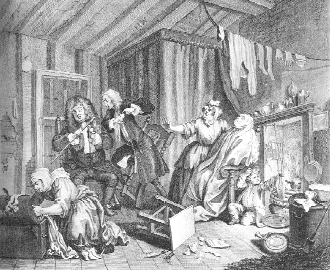
- Dr Rock and Dr Misaubin
- In the fifth and last plate of The Harlot’s Progress (1732) which shows the garret where Mary Hackabout is dying, two doctors are quarelling, unable to save her: one of them, very fat, is identified as Dr Rock, the other one, a long lean man, is Dr Misaubin.
[click on the picture to enlarge it]
Though Dr Misaubin’s fame is not due to his medical talents, his name has been passed on to posterity thanks to Hogarth and Watteau.
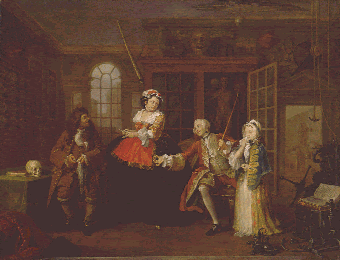
- A Visit to the Quack
- (c) National Gallery, London
[click on the picture to enlarge it]
Also, in the series Marriage à la Mode (1745), the setting for the third plate entitled A Visit to the Quack is probably Dr Misaubin’s practice at 96 St Martin’s Lane (near Leicester Square, where writers and artists lived).
The scene shows the young nobleman (who has married the City heiress for money) taking a girl he has seduced to see the quack-doctor.
The window to the left is a Venetian window, a Palladian motif hated by Hogarth and much used by an architect he disliked, Kent. Such architecture, which Hogarth considered as rigid, is chosen by Hogarth as a backdrop for his story of immorality in high society.
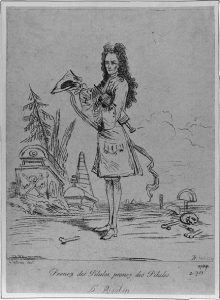
- Dr Misaubin by Watteau
- Dr Misaubin by Watteau (British Museum, 1733)
[click on the picture to enlarge it]
Watteau shows Dr Misaubin as a long, lean man, with a wasted face framed in a falling wig, holding in his right hand a three-cornered hat adorned with a black floating hatband and maintaining with his left arm a clyster (probably meant for the patients suffering from venereal diseases). He is standing in front of a heap of coffins. This macabre allegory bears as a legend “take pills, take pills!”.
Fielding twice evokes Misaubin’s name in The History of Tom Jones (1749), to ridicule his strong foreign accent:
Agreeable to these Observations was, I remember, the Complaint of the Doctor Misaubin who used very pathetically to lament on the late Applications which were made to his Skill: Saying ’Bygar, me believe my Pation take me for the Undertaker: for day never send for me till de Physicion have killed dem’" (V.vii).
He also mentions him ironically as an example of someone who is so well-known that he does not need to give his address.

